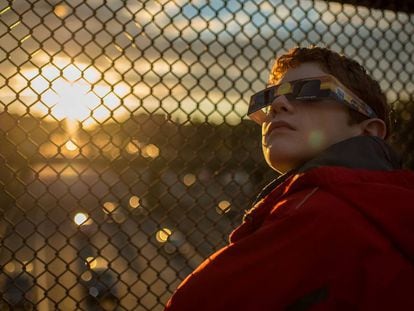Where to see the solar eclipse in Spain
The astronomic event of the year can be partially observed from the mainland and the Canaries
Tonight, the Moon will pass directly in between the Earth and the Sun causing a total solar eclipse for more than two minutes as it crosses North America moving from the west coast to the east, ending in Cape Verde in the Atlantic Ocean. A partial eclipse will be visible from much of Spain and Portugal, as well as in the Canary Islands, Canada, Central America, the northern part of South America, Western Europe, North Africa, and northeastern Russia.

In Spain, the partial eclipse will be visible shortly before sunset and can be viewed best in the extreme northwest of the country. Vigo, a port city in the region of Galicia, is where the sun will be most covered, with an eclipse of 14%. The event will begin at 8.44pm and last until 9.20pm, a couple of minutes before sunset, according to Spanish astronomers association Saros. In the Canary Islands, the sun will be somewhat higher on the horizon and a partial eclipse of 30% is expected. On the island of La Palma, the latest the eclipse will occur is 8.40pm local time, about three minutes before sunset. In Tenerife, the peak time for the eclipse will be at 8.41pm, after the sun has already set, according to the Canaries Institute of Astrophysics .

“At the time of the eclipse, the sun will be very low on the horizon, and it is possible that the calima, a dusty, sand-laden wind, will impede people from seeing it,” says Ricard Casas, an astronomer at the Higher Council for Scientific Research. The scientist warns that precautions must be taken to observe an event of this type to avoid suffering serious injuries. “Looking directly at the sun can cause burns on the retina,” says Casas. “If you’re going to look directly at the phenomenon, it’s necessary to use filters on telescopes and binoculars or special eclipse glasses.” He adds that any place where you can see a clear horizon is a good place to watch the event.
Perhaps the best way to see the eclipse from Spain is by connecting to the Internet. NASA selected Mackay, Idaho as its official location to watch the event and from where it will be broadcasting live. A group of Spanish astronomers formed by the Stars4all project will be traveling to Idaho to view the eclipse and have their own broadcast, starting at 6pm, peninsular time.
Perhaps the best way to see the eclipse from Spain is by connecting to the Internet
Not only is the “great American eclipse” the astronomical spectacle of the year, it can also serve as a scientific measuring instrument. Current solar telescopes create artificial eclipses by placing black circles in front of the solar disk, which allows people to study the outermost layer of the sun, such as the chromosphere. “Dozens of years ago,” explains Casas, “the only way to make these kinds of observations was during eclipses, when the Moon covered most the star’s light.” These phenomena are quite common and it allows for an accurate measurement of the Sun’s diameter. “As we know the diameter of the Moon very well and it has no atmosphere, we can use a total eclipse to calculate the exact diameter of the Sun,” adds Casas. The sun is a very stable star, so its dimensions barely change. The next total eclipse in Spain will be on August 12, 2026.
English version by Debora Almeida.













































